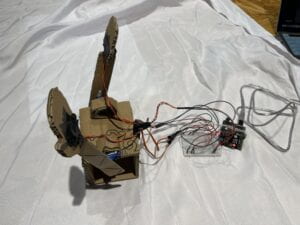“Super Lesioning Advanced Playing slapBox Offense Technology,” also known as “S.L.A.P.B.O.T.” is me and my partner, Ryan Hiew’s, midterm collaboration project. Essentially, we wanted to create a robotic recreation of the commonly played real-life game “slap-bet.” The original game revolved around two people placing both of their respective hands onto the other one. Whoever had their hands placed at the bottom, would try to slap the second person in the back of their hand and the second person would try to react to the slap and move out of the way. We wanted to create this same nostalgic game into a more modern setting and make cold metal and plastic parts slap a person’s hand instead as we thought it would invoke more pain and fear into the player.
The idea for our project came from a quick brainstorming session that ultimately resulted in us talking about nostalgic mini-games that we used to play anywhere. We got to the subject of the “slap bet” game and we both agreed that it was more fun when each player tried to hurt the other player’s hand as much as possible as it gave the game a sense of thrill. I guess this project was influenced slightly from my group’s research presentation where I played an unfeeling and rude robot assistant. Ryan and I both thought it would be funny to strike fear into people’s minds by making the game way more scary and anxiety-inducing by making the timing random as well as fast while attempting to avoid being slapped by a cold, unfeeling machine. We took the idea a little further by thinking about adding cardboard spikes to the hand of the robot, but we eventually decided that it would probably ruin the aesthetic of the robot as well as having to change the name to “S.T.A.B.B.O.T.”.
“SLAPBOT” revolves mostly around the aesthetic of the cardboard fingerless hands attached to a cardboard box. Both hands as facing the floor and are attached to a servo motor. Once activated, both hands start flailing up and down as if trying to slap someone. Getting people to actually start the mini-game was the most difficult part of our project as we had so much trouble getting the infrared sensors (the sensors that picked up if someone had been touched by the hands) to work that we did not design the feedback system nor the user design very well. Once we reached the user-testing phase, we had only designed one of the slapping arms with barely any user design or feedback. The project worked fairly well, slapping anyone’s hand that came across it and stopping while printing “HAHA LOSER YOU LOSE” in the serial monitor if the player had been slapped. However, a mere part of the project as well as no feedback other than the serial monitor really hurt the project’s lucidity to the testers.
User testing era SLAPPER: https://youtu.be/sgRPzl4bSXw

The final part of the project came by too fast. We had originally planned to add sound feedback whenever the player lost as well as another feedback mechanism that would turn on a light when the player lost. However, because of some issues with the code, adding the second arm to the SLAPBOT was much more difficult than expected. We eventually got it to work, but by then there was already barely any time to build and code anything extra. Unfortunately, our only choice was to make it more interesting through a little bit of code. We decided to attach the second arm of the SLAPBOT on the opposite side of the machine and make the slapper into a competition between two players, since the spirit of the original game was competition. Ultimately, this aspect was more of a hinderance than an addition since more than one person pointed out that the project relied too heavily on a two-player mode and could not stand out too much on its own.
Final version of SLAPBOT: https://youtube.com/shorts/DuSLMNeHxhA?feature=share

This project could definitely have gone much smoother with the building process. If that had happened, we definitely would have completed a much better user-interface and feedback system as well as making the project much more polished in general. The main problem’s focal point was the lack of time after making the second arm work. If I could do it again, I would focus less on the arms and build/draw the interface better. However, I am still thankful for the project we had built and how it had functioned despite its hiccups.
